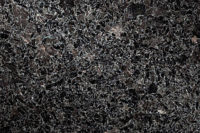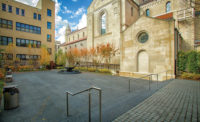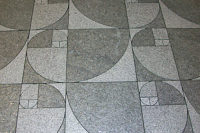In operation for 20 years, the Coldspring quarries for Mesabi Black and Lake Superior Green®granite in northern Minnesota have supplied major architectural, landscape and memorial projects throughout the U.S. In one of the most prominent uses of the materials to date, Mesabi Black is currently being used for work at the World Trade Center site in New York City.
Both quarries sit within Superior National Forest, and the State of Minnesota approached Coldspring to explore the land in the early 1990s. “The state was looking to diversify production in the forest beyond timber,” explained Dan Rea, Senior Vice President at Coldspring. “Stone outcroppings were identified with aerial photos. Coldspring took core samples to determine color, crystal structure and soundness of the natural stone deposits. Both sites demonstrated sufficient evidence a quarry operation could be sustained within the guidelines established by the government with respect to land use and site reclamation. The material also exhibited a yield average potential in line with many of our existing operations. Also, our market research indicated a need for both colors and we started operations in 1994. Both deposits are performing to our expectations.”
Mesabi Black
Located near Babbitt, MN, the Mesabi Black quarry produces over 200,000 cubic feet of material per year, reaching 225,000 cubic feet in 2012, as it was supplying material for use on the interior as well as the exterior of the World Trade Center project. For this project, the material was specified for interior and exterior paving, curbs, sidewalks and other architectural and landscape elements.
“This material will be a very prominent element for Lower Manhattan,” Rea said. “It was a multi-year process of working with the architects and the owners on specifications and mock-ups. It was 125,000 cubic feet in all, and we quarried it in advance.”
The quarry operates with a crew of nine workers, which can move to the Lake Superior Green quarry (about an hour away) as needed. “It is a balance to keep the quarry prepared,” said Mark Roettger, Director of Quarries Operations for Coldspring. “You look at inventory versus demand and producing sizes that people want.”
Throughput at the quarry is carefully managed, including material pulled from the ground versus what is put on the truck. The office at the quarry site has detailed cost analyses that track the optimization of the natural resource.”We always want to minimize our impact to the site we are operating in,” Rea said. “Tracking cost and yield manages our efforts. We use sales forecasts to create visibility to our quarry managers and employees about potential demand. This forecast, in conjunction with the quarry’s yield and operational capacity, creates the extraction plan that balances short-term demand with long-term management of the resource.”
Operations at the quarry rely heavily on diamond wire sawing. “We are focusing on maximizing yield,” said Roettger. “We are optimizing wire sawing as opposed to using a drill and wedge. The keyways are flat sawed, and then we do a light bump two or three times a week.”
In extracting the stone, massive “slabs” are vertically sawn and freed from the quarry face before being further processed into gangsaw-sized blocks. These “slabs” are numbered, and the resulting blocks can be traced all the way back to the exact location where they were pulled from the quarry site. “Although Mesabi Black is one of the most consistent black granites marketed today, like all of our quarries, there are shade variances that may require additional culling, which is aided by quarry in situtracking,” said Rea.
When the owner and architect visited the Mesabi Black quarry for the World Trade Center project, a specific area of the site was requested to supply the blocks. In addition to the World Trade Center, Mesabi Black has been used for notable projects such as the Kogod Courtyard at the Smithsonian Institute in Washington, DC, Intuit’s headquarters in Mountain View, CA, and the Wall of Remembrance at Eagle Circle in Pablo, MT.
All of the blocks extracted from the Mesabi Black quarry are labeled with their character, color and grade, and this inventory is stored on a computer database.
Within the quarry, the majority of the diamond wire saws are from Pellegrini of Italy, and most of the wire is from Diamant Boart. Recent investments in drilling equipment include a Perfora Girodrill 200, a compact, four-wheel drive, Tophammer drill rig, which features two hydraulic rock drills. “The idea is to separate the man from the drill,” Roettger said. “It is programmable and will give us a better yield with no human fatigue.”
Also improving operations, Coldspring has brought in a Micheletti Telestar Climber diamond wire saw for block trimming. The machine runs on a hydraulic track, and it can easily be moved from block to block — allowing it to systematically trim multiple blocks in a sequence without moving each one. “It is becoming our standard for diamond wire trimming,” Roettger said. “We are bringing the tool to the blocks and not the blocks to the tool. We keep the saw running approximately 82% of the time, and we’re paying close attention to our cutting costs. By measuring everything, you know if you’re improving.”
The quarry operates year round, as the loaders can easily remove snow from the active areas of the site as needed. “Ice can be an issue, so we avoid areas with high groundwater,” Roettger said.
With temperatures at the quarry site reaching as low as -20 degrees F, measures have to be taken to offset the cold. The water used during the process is heated as needed, and a spray foam solution also helps combat freezing.
The quarry site has an equipment storage/maintenance facility that allows them to start all of the equipment indoors, which is particularly useful during the colder winter months.
Lake Superior Green
Coldspring’s site for Lake Superior Green granite is located near Isabella, MN. As needed, the quarry is operated by the same crew that works the Mesabi Black quarry.
Inventory is taken off site to await shipping or processing. In an effort to maximize production, crews are producing gangsaw-sized blocks as well as smaller blocks. Roettger said. “The plant utilizes the small blocks, as they work well with the diamond wires and gangsaws, satisfying customer demand.”
The biggest challenge in the Lake Superior Green is the natural characteristics of the site. “There is a lot of instinct needed on where you want to go,” Roettger said. “You are basically looking for ‘balls’ of good stone and working in from there.”
Lake Superior Green has been used for notable projects such as the sitework at Ralph Carr Judicial Building in Denver, CO, the National D-Day Memorial in Bedford, VA, Citygarden in St. Louis, MO, and Victory Memorial Drive in Minneapolis, MN. “Like Mesabi Black, the stone has a very high level of consistency, making it an excellent choice for large projects,” Rea said.
























